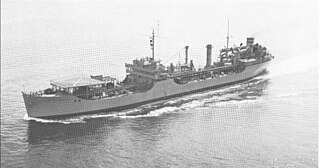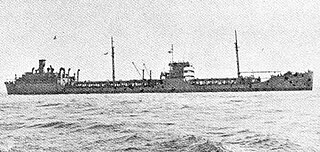
The Cimarron-class oilers were an underway replenishment class of oil tankers which were first built in 1939 as "National Defense Tankers," United States Maritime Commission Type T3-S2-A1, designed "to conform to the approved characteristics for naval auxiliaries in speed, radius and structural strength", anticipating their militarization in the event of war. "Tentative plans had been reached with the Standard Oil Company of New Jersey to build ten high-speed tankers with the government paying the cost of the larger engines needed for increased speed. By the first week in December [1937], Standard Oil had solicited and received bids from a number of yards providing for the construction of a number of 16,300-ton (deadweight) capacity tankers. Bids were requested for two versions: a single-screw design of 13 knots and a twin-screw design of 18 knots. The price difference between the two would be used to establish the government's cost subsidy for greater speed. Plans and specifications for both designs were prepared for Standard Oil by naval architect E. L. Stewart. It seems certain that the design for the 18-knot tanker evolved out of the bureau's (C&R) design for a fleet oiler."

SS Mission Capistrano was a Type T2-SE-A2 tanker built for the United States Maritime Commission during World War II. After the war she was acquired by the United States Navy as USS Mission Capistrano (AO-112). Later the tanker transferred to the Military Sea Transportation Service as USNS Mission Capistrano (T-AO-112). She was a Mission Buenaventura-class oiler and was named for San Juan Capistrano in San Juan Capistrano, California.

SS Mission San Gabriel was a Type T2-SE-A2 tanker built for the United States Maritime Commission during World War II. After the war she was acquired by the United States Navy as USS Mission San Gabriel (AO-124). Later the tanker transferred to the Military Sea Transportation Service as USNS Mission San Gabriel (T-AO-124). She was a member of the Mission Buenaventura-class oiler and was named for the Mission San Gabriel Arcángel, she was the only U.S. Naval vessel to bear the name.

SS Mission Santa Ynez was a Type T2-SE-A2 tanker built for the United States Maritime Commission during World War II. After the war she was acquired by the United States Navy as USS Mission Santa Ynez (AO-134). Later the tanker transferred to the Military Sea Transportation Service as USNS Mission Santa Ynez (T-AO-134). A Mission Buenaventura-class oiler, she was named for Mission Santa Inés located in Solvang, California.

USNS Redstone, designated T‑AGM‑20, was a tracking ship assigned to Apollo space mission support under the control of the Eastern Range. For a brief time during conversion the ship was named Johnstown with the designation AGM‑20.
SS Mission San Antonio was a Type T2-SE-A2 tanker built for the United States Maritime Commission during World War II. After the war she was acquired by the United States Navy as USS Mission San Antonio (AO-119). Later the tanker transferred to the Military Sea Transportation Service as USNS Mission San Antonio (T-AO-119). She was a Mission Buenaventura-class oiler and was named for Mission San Antonio de Padua located near Jolon, California.

SS Mission San Diego was a Type T2-SE-A2 tanker built for the United States Maritime Commission during World War II. After the war she was acquired by the United States Navy as USS Mission San Diego (AO-121). Later the tanker transferred to the Military Sea Transportation Service as USNS Mission San Diego (T-AO-121). She was a member of the Mission Buenaventura-class oiler and was named for the Mission San Diego de Alcalá.

SS Mission San Fernando was a Type T2-SE-A2 tanker built for the United States Maritime Commission during World War II. After the war she was acquired by the United States Navy as USS Mission San Fernando (AO-122). Later the tanker transferred to the Military Sea Transportation Service as USNS Mission San Fernando (T-AO-122). She was a member of the Mission Buenaventura-class oiler and was named for Mission San Fernando Rey de España in Los Angeles. She was later renamed USNS Muscle Shoals (T-AGM-19), and, later, USNS Vanguard (T-AG-194).

USNS Mission Santa Ana (T-AO-137) was a Mission Buenaventura-class oiler that served in the United States Navy. The ship was originally intended as USS Concho (AO-102) for the U.S. Navy but her acquisition was canceled. The ship, a Type T2-SE-A3 tanker, was completed as SS Mission Santa Ana and delivered after the end of World War II. The tanker was acquired by the U.S. Navy in 1948 as USS Mission Santa Ana (AO-137), but was transferred to the Military Sea Transport Service upon its creation in 1949. The ship was named for the Santa Ana Estancia, she was the only U.S. Naval Vessel to bear the name.
SS Mission Santa Barbara was a Type T2-SE-A2 tanker built for the United States Maritime Commission during World War II. After the war she was acquired by the United States Navy as USS Mission Santa Barbara (AO-131). Later the tanker transferred to the Military Sea Transportation Service as USNS Mission Santa Barbara (T-AO-131). She was a Mission Buenaventura-class oiler and was named for Mission Santa Barbara in Santa Barbara, California.
SS Mission Santa Clara was a Type T2-SE-A2 tanker built for the United States Maritime Commission during World War II. After the war she was acquired by the United States Navy as USS Mission Santa Clara (AO-132). Later the tanker transferred to the Military Sea Transportation Service as USNS Mission Santa Clara (T-AO-132). She was a Mission Buenaventura-class oiler and was named for Mission Santa Clara de Asís in Santa Clara, California.
SS Mission Soledad was a Type T2-SE-A2 tanker built for the United States Maritime Commission during World War II. After the war she was acquired by the United States Navy as USS Mission Soledad (AO-136). Later the tanker transferred to the Military Sea Transportation Service as USNS Mission Soledad (T-AO-136). She was a member of the Mission Buenaventura-class oiler and was named for Mission Nuestra Señora de la Soledad, located in Soledad, California.

USS Saugatuck (AO-75) was a Suamico-class replenishment oiler of the United States Navy.

USS Soubarissen (AO-93) was an Escambia-class fleet oiler converted to a water tanker, named for a chief of the "Neutral" Indian Nations which, although a part of the Iroquois confederation, were called "neutral" by the French because they took no part in the wars of the Iroquois and Hurons. The area he governed included the oil fields of northwestern Pennsylvania and western New York. The knowledge of the oil seepages there was well known among the Indians, and it was declared neutral ground so all Indians could obtain oil for medicinal and domestic purposes without danger or interference. In 1627, Joseph de La Roche Daillon heard of the oil springs and made an expedition to visit them. He was kindly received by Chief Soubarissen, shown the oil seepages, and duly reported his observations to his superiors. These observations contributed largely to the interest in the petroleum resources of the Pennsylvania region.

USS Marias (AO-57) was a Cimarron-class fleet oiler acquired by the U.S. Navy during World War II. She served her country primarily in the Pacific Ocean Theatre of Operations, and provided petroleum products where needed to combat ships. For performing this dangerous task, she was awarded eight battle stars during World War II, and one campaign star during the Vietnam War for her bravery in combat areas.

USS Cohocton (AO-101) was lead ship of her class of fleet oiler acquired by the United States Navy for use during World War II. She had the dangerous but necessary task of providing fuel to vessels in combat and non-combat areas. She served in the Pacific Ocean Theatre of operations late in the war.

USS Mississinewa (AO-144) was a Neosho-class fleet oiler of the United States Navy in service from 1955 to the early 1990s.

USS Passumpsic (AO-107), the only United States Navy ship to bear the name, was an Ashtabula-class fleet replenishment oiler that served in the U.S. Navy from 1946 to 1973, then transferred to the Military Sealift Command to continue service as United States Naval Ship USNS Passumpsic (T-AO-107). She was the only U.S. Navy ship to bear the name Passumpsic, after the Passumpsic River in Vermont.

USS Pawcatuck (AO-108) was a T3 Ashtabula class replenishment oiler tanker that served in the U.S. Navy from 1946 to 1975, then transferred to the Military Sealift Command to continue in non-commissioned service with a civilian crew as United States Naval Ship USNS Pawcatuck (T-AO-108). She was the only United States Navy ship to bear the name Pawcatuck.


















